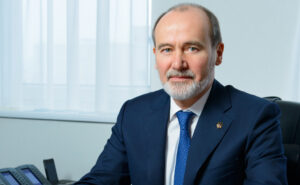
First Logistics Company (FLC), a leader in grain transportation by rail, has demonstrated growth in freight traffic for the third consecutive year. In particular, in 2025, it increased the transportation of agricultural products by 8.1% and construction materials by 6.8% compared to 2024, according to the company’s press service.
“A year of challenges, a year of tension, a year of working in conditions of full-scale war. And at the same time, another year in which we proved that development is possible even in the most difficult conditions,” the company wrote on its Facebook page.
PLK specified that in 2025, it transported 2.26 million tons (48.7%) of grain cargo and 1.16 million tons (51.3%) of inert materials. Of this, 900,000 tons were delivered to Ukrainian seaports and 200,000 tons to the land border with the EU.
As the company noted, these results were made possible by the work of the team, the trust of customers and partners, and the defenders of Ukraine, who ensure the ability to work in wartime conditions.
PLC expressed its conviction that in 2026 it will be able to achieve even greater results — already in the conditions of recovery and development of a peaceful Ukraine.
First Logistics Company is one of the leaders in the Ukrainian market for the transportation of grain crops by rail. It cooperates with international traders ADM, Bunge, CHS, NCH, Louis Dreyfus, Glencore, Cargill, and others. It has its own rolling stock of over a thousand railway cars and leased cars of various modifications.
PLC provides a full range of services in the field of freight transportation by rail and is part of the MS Capital holding. MS Capital also includes Ukraine’s largest Audi dealership, Audi Center Odessa South, the Avtostrada group of companies, the Pryluky Agricultural Company, and the Bekhivsky Granite Quarry.
According to YouControl, the founder and beneficiary of First Logistics Company is Maxim Shkil.

January 4 marked World Braille Day, established by the UN General Assembly to raise awareness of the importance of Braille as a means of communication and the realization of the rights of blind and visually impaired people.
In Ukraine, according to the National Health Service of Ukraine, there has been an increase in the number of cases of vision loss or deterioration: in 2021, 17,478 such diagnoses were registered, in 2022 – 19,551, and in the first seven months of 2023, doctors have already recorded more than 19,000 diagnoses, which exceeded the figure for the whole of 2022. This was reported by the Ministry of Social Policy of Ukraine, noting the impact of full-scale war on the increase in the number of people with visual impairments.
At the same time, official statistics do not usually provide a single public “consolidated” figure for the total number of blind and visually impaired people in Ukraine. Public and specialized resources in various estimates cite figures of around 70,000 blind people and around 100,000 people with visual impairments (including children), emphasizing that these are estimates.
The Braille alphabet was created by French educator Louis Braille: he began working on the tactile code in 1824, based on the ideas of Charles Barbier’s “night writing” developed for the military. Braille adapted the six-dot cell-based system for easy reading and writing by the blind, and the first edition of his method was published in 1829.

Citizens of Ukraine at the end of the third quarter of 2025 entered the top ten largest foreign buyers of real estate in Spain – they accounted for 758 sales transactions, according to the data of the Spanish Registration Service (Registrars) for Q3.
Leaders among foreign buyers were citizens of the UK (1 871 transactions), Germany (1 539) and the Netherlands (1 416). Romania (1,321) and Morocco (1,317) followed, as well as France (1,241) and Italy (1,177).
Poland (1,096) and Belgium (1,021) are also in the top 10. Ukraine ranked 10th (758), ahead of China (687) and Sweden (578).
Other countries represented in the statistics include Ireland (424 transactions), the US (405), Russia (403) and Bulgaria (251).

The state-owned enterprise “Forests of Ukraine” has completed auctions for the first quarter of 2026, during which almost all forest products were contracted, prices for hardwood species continued to rise, and prices for coniferous species stabilized, the press service of the state-owned enterprise reported.
“Forests of Ukraine” noted that the auctions were held for the first time under the zero quota for firewood exports introduced by the Cabinet of Ministers. However, in the process of competitive struggle for resources, market participants once again reached higher price levels.
Thus, 381,000 cubic meters were put up for quarterly auctions for the sale of industrial wood (PV), and almost 100% was contracted. Compared to the fourth quarter, the average price of firewood rose from UAH 2,300/cubic meter to UAH 2,600/cubic meter. The main reason was the rise in the price of hardwood from UAH 2,300/cubic meter to UAH 3,000/cubic meter. At the same time, the market value of softwood did not change significantly and amounted to UAH 2,400/cubic meter.
It is noted that the supply of firewood for sale by the State Enterprise “Forests of Ukraine” was distributed almost equally between quarterly and semi-annual (forward) auctions. The forward contracts for the first half of the year took place earlier: 100% of the resource (741 thousand cubic meters) was sold, with an average sale price of UAH 2.4 thousand/cubic meter.
“The tool for hedging price risks by concluding long-term contracts has once again proven its effectiveness. At least in the first quarter, products under semi-annual contracts for firewood will be slightly cheaper,” the state-owned enterprise stated.
Of the 775,000 cubic meters of round timber put up for sale at quarterly auctions, more than 99.5% was sold. The average selling price increased from UAH 6,800/cubic meter in the fourth quarter to UAH 7,300/cubic meter.
At the same time, “Forests of Ukraine” considers it incorrect to talk about a general increase in prices for commercial timber, since birch rose in price from UAH 5,700/cubic meter to UAH 7,600/cubic meter, oak from UAH 22,000/cubic meter to UAH 28,000/cubic meter, and ash from 8,000 UAH/cubic meter to 11,000 UAH/cubic meter. At the same time, alder has become cheaper, falling from 6,700 UAH/cubic meter to 5,900 UAH/cubic meter, and pine from 5,900 UAH/cubic meter to 5,600 UAH/cubic meter.
About 25% of the resource (654 thousand cubic meters) was put up for forward trading in commercial timber for the first half of the year. The average selling price at forward trading was slightly lower than the quarterly price and amounted to UAH 7.2 thousand/cubic meter. At the same time, while oak and ash were indeed contracted at prices lower than those at quarterly auctions, the situation was reversed for coniferous species, the state-owned enterprise noted.

In December, Viktor Ivanchik, CEO of Astarta agricultural holding, bought 134,640 shares, or 0.53856% of the total number of shares, on the Warsaw Stock Exchange (WSE) and outside it through Albacon Ventures Limited at an average price of PLN51.93 per share.
According to stock exchange reports, transactions were concluded on the stock exchange on 14 days in December, during which a total of 50,334 thousand shares were purchased at an average price of PLN45.94 per share, and on December 19, an off-exchange transaction was concluded to purchase 84,306 thousand shares at a price of PLN55.5 per share.
In total, in December, the CEO of Astarta paid PLN6.99 million, or about $1.94 million at the current exchange rate, for additional shares, while in November he purchased 100 thousand shares on the stock exchange for PLN4.66 million, or about $1.29 million at the current exchange rate.
It is noted that after these transactions, Ivanchik owns 10 million 913.25 thousand shares of the agricultural holding, or 43.653% of their total number.
Prior to this, on September 15, Ivanchik purchased 244,679 thousand shares outside the stock exchange, or 0.9787% of their total number, also at a price of PLN55.5 per share, which is significantly higher than the quotation on the Warsaw Stock Exchange.
As of this Monday at 11:50 a.m., Astarta shares are trading on the stock exchange at PLN45.1, giving the company a market capitalization of PLN1.128 billion, or about $312.7 million.
According to the latest report, at the end of September this year, the Ivanchik family owned a total of 43.21% of shares, compared to 42.23% of shares in the middle of the year, 41.48% at the beginning of this year, and 41.28% at the end of September last year. Fairfax Financial Holdings has also been a major shareholder all this time, with 29.91%, while another 2.1184% of shares are owned by the company itself and were previously repurchased as part of a buyback. As of May this year, minority shareholders also included Kopernik Global Investors with 2.64% and Heptagon Capital with 1.8%.
Astarta is a vertically integrated agro-industrial holding company operating in eight regions of Ukraine and is the largest sugar producer in Ukraine. It comprises six sugar factories, agricultural enterprises with a land bank of 220,000 hectares, dairy farms with 22,000 head of cattle, an oil extraction plant in Hlobine (Poltava region), seven elevators, and a biogas complex.
In January-September 2025, Astarta reduced its net profit by 42.2% to EUR43.70 million, and its consolidated revenue decreased by 22.4% to EUR342.78 million.
On June 12 this year, the shareholders’ meeting approved the payment of dividends for 2024 in the amount of EUR0.5 per share for a total of EUR12.5 million, which is in line with the figures for the previous two years.

As of the end of 2025, 37 industrial enterprises have been built or are under construction in Ukraine’s industrial parks, of which 22 factories have already been built and 15 are under construction, according to the Ministry of Economy, Environment, and Agriculture. As reported, by the end of 2024, 25 industrial enterprises were operating or under construction in industrial parks, of which 12 had been built.
Among those operating or under construction as of the end of last year were enterprises in the fields of agro-processing, food production, furniture and woodworking, machine building, and others. Operating enterprises created 3,716 jobs.
The Ministry of Economy also recalls that in 2025, it decided to provide state incentives to 13 industrial parks for the implementation of 22 infrastructure projects totaling UAH 697.77 million.
In addition, UAH 202.91 million was transferred during the year to two industrial parks, the decisions on which were made in 2024.
Thus, the total amount of state incentives for industrial parks in 2025 amounted to UAH 900.681 million, the ministry concludes.
“2025 was the year when the number of industrial parks turned into real platforms for the implementation of the ”Made in Ukraine” policy. Almost UAH 1 billion in state incentives for industrial parks this year is an investment in infrastructure that is already giving life to new factories today. The state is laying the foundation, and business is turning it into new capacity and jobs,” Economy Minister Oleksiy Sobolev is quoted as saying in the statement.
As reported, 13 industrial parks received state incentives last year.
As of December 31, 2025, 118 industrial parks were included in the Register of Industrial Parks, of which 24 parks were included during 2025. At the same time, eight parks that did not carry out any activities were excluded from the Register.
The State Incentives for the Creation of Industrial Parks program provides for the development of engineering and transport infrastructure in industrial parks on a co-financing basis. State support may be directed toward the construction of roads, electrical networks, water supply and sewage systems, gas supply, and other technical solutions necessary for the launch of production.
State incentives provide for co-financing in a ratio of 50% to 50% for up to UAH 150 million per IP, and for de-occupied territories in a ratio of 80% to 20%.
The Ministry of Economy is implementing the program in cooperation with Ukreximbank, Oschadbank, Ukrgasbank, and Sens Bank.
A number of fiscal incentives are also provided for IP participants.